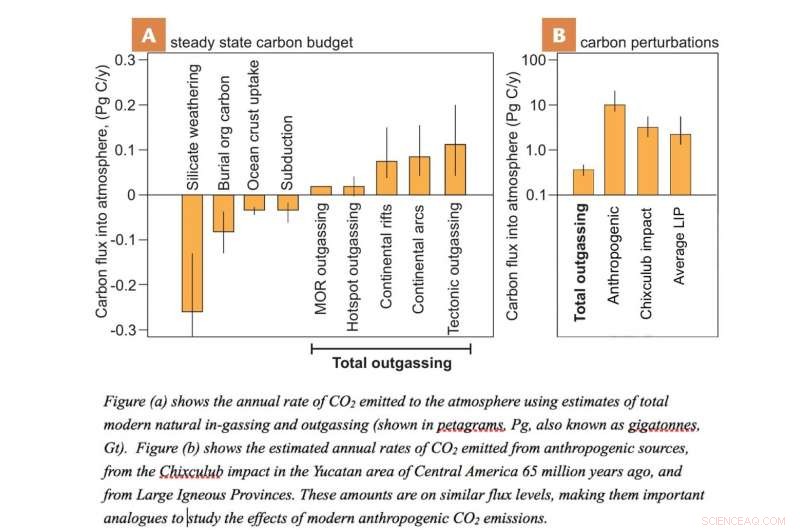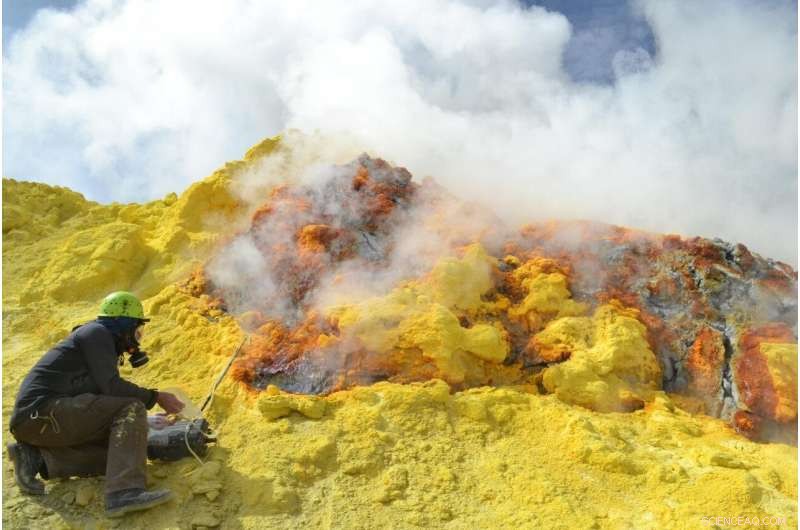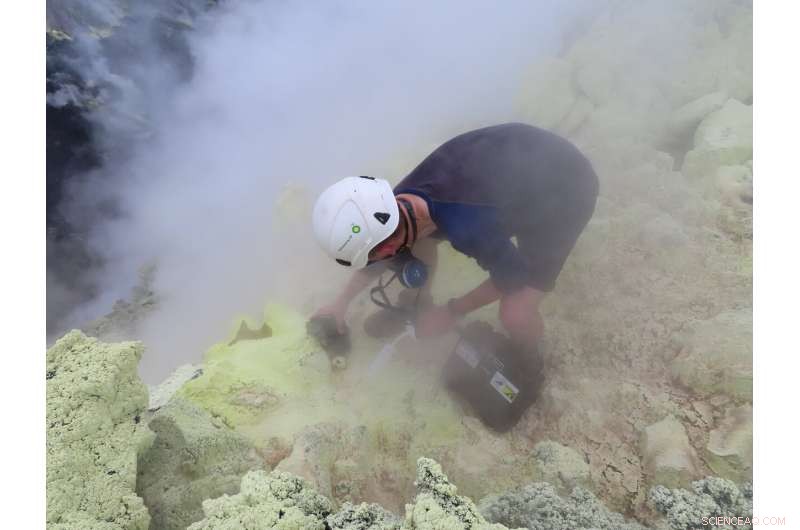
Histogram för kolinflöde (positiva värden) och utflöde (negativa värden) till atmosfären och haven. Enheterna är i Pg C/y. (A) Kolflöden baserade på steady state -modeller. Förkortningar:MOR =mid ocean ridge; org kol =organiskt kol. (B) Kolflöden till följd av storskaliga störningar av kolcykeln. Total avgasning avser händelser som anges i figur 2A; antropogen är mänskliga bidrag; Chicxulub (Mexiko) hänvisar till slutet av kritt-asteroiden och den resulterande massutrotningen; genomsnittlig LIP avser input från stora vulkaniska provinser. Data från Kawaragi et al. (2009), Lee et al. (2019) och Black and Gibson (2019) Kredit:Deep Carbon Observatory
Vulkaner, kolliderar och sprider kontinentala och oceaniska plattor, och andra fenomen som omstudierats med innovativa högteknologiska verktyg, ge viktig ny insikt om jordens innersta funktioner, säger forskare.
Förbereder att sammanfatta och fira det 10-åriga Deep Carbon Observatory-programmet vid National Academy of Sciences, Washington DC, 24-26 oktober, DCO:s reservoarer och Fluxes-team på 500 medlemmar beskriver idag flera viktiga fynd som sträcker sig från nuet till miljarder år sedan; från jordens kärna till dess atmosfär, och i storlek från enstaka vulkaner till de fem kontinenterna.
Bland många omfattande fynd, beskrivs och sammanfattas i en serie artiklar publicerade i tidningen Element:
Säger DCO -forskaren Marie Edmonds från University of Cambridge, Storbritannien:"Kol, grunden för allt liv och den energikälla som är avgörande för mänskligheten, rör sig genom denna planet från dess mantel till atmosfären. För att säkra en hållbar framtid, Det är av yttersta vikt att vi förstår jordens hela koldioxidcykel. "
"Nyckeln till att reda ut planetens naturliga kolcykel är att kvantifiera hur mycket kol det finns och var, hur mycket rör sig - flödet - och hur snabbt, från Deep Earth -reservoarer till ytan och tillbaka igen. "
Lägger till kollegan Tobias Fischer från University of New Mexico, USA:"Deep Carbon Observatory har avancerad förståelse för jordens inre arbete. Dess kollektiva grupp med mer än 1500 publikationer har inte bara ökat vad som är känt utan har fastställt gränser för vad som är känt, och kanske omedvetet. "
"Medan vi firar framsteg, vi understryker att djupa jorden fortfarande är en mycket oförutsägbar vetenskaplig gräns; vi har verkligen bara börjat skära nuvarande gränser för vår kunskap. "
Hur mycket kol innehåller jorden?
Forskare har länge vetat att kol inuti jorden finns som en mängd olika fasta ämnen, vätskor, och gaser. Några av dessa material innefattar kombinationer av kol med syre (t.ex. koldioxid), med järn (t.ex. karbider), med väte (t.ex. kerogen, kol, petroleum, och metan), och andra element (t.ex. kisel, svavel, och kväve), förutom elementärt kol (t.ex. grafit och diamant).
Deep Carbon Observatory -forskare understryker att kunskapen om totalt kol i nedre manteln och kärnan fortfarande är spekulativ och siffrorna kommer säkert att utvecklas med precision när forskningen fortsätter. Som sagt, experter (särskilt Lee et al ., 2019) uppskatta kolreservoarer på jorden enligt följande:
Med siffrorna:Bästa aktuella uppskattningar, kol på jorden
1,85 miljarder gigatonn (1,85 x 1 miljard x 1 miljard ton):Totalt kol på jorden

Gasprovtagning vid Lastarria Volcano (norra Chile) under Trail by Fire -expeditionen (trailbyfire.org) Kredit:Yves Moussallam, Lamont Doherty Earth Observatory
Bryta ner:
Utsläpp av CO 2 from volcanoes
Earth's total annual out-gassing of CO 2 via volcanoes and through other geological processes such as the heating of limestone in mountain belts is newly estimated by DCO experts at roughly 300 to 400 million metric tonnes (0.3 to 0.4 Gt).
Volcanoes and volcanic regions alone outgas an estimated 280-360 million tonnes (0.28 to 0.36 Gt) of CO 2 per year. This includes the CO 2 contribution from active volcanic vents, from the diffuse, widespread release of CO 2 through soils, faults, and fractures in volcanic regions, volcanic lakes, and from the mid-ocean ridge system.
In many world regions, tectonic outgassing (emissions from mountain belts and other plate boundaries), particularly in cool night temperatures, can cause dangerous levels of CO 2 close to the ground—enough to suffocate livestock.
According to DCO researchers, with rare exceptions over millions of years the quantity of carbon released from Earth's mantle has been in relative balance with the quantity returned through the downward subduction of tectonic plates and other processes.
Carbon catastrophes
While the volume of carbon buried through subduction and what's released from volcanoes and tectonic fractures are normally in steady state, about four times over the past 500 million years this balance has been upended by the emergence of large volcanic events—1 million or more square kilometers (the area of Canada) of magma released within a timeframe of a few tens of thousands of years up to 1 million years.
These "large igneous provinces" degassed enormous volumes of carbon (estimated at up to 30, 000 Gt—equal to about 70% of the estimated 43, 500 Gt of carbon above surface today).
Carbon cycle imbalance can cause rapid global warming, changes to the silicate weathering rate, changes to the hydrologic cycle, and overall rapid habitat changes that can cause mass extinction as the Earth rebalances itself.
Similar carbon catastrophes have been caused by asteroids / meteors (bolides), such as the massive Chixculub impact in the Yucatan area of Central America 65 million years ago—an event to which extinction of the dinosaurs and most other plants and animals of the time has been attributed.

Year-round monitoring at five volcanoes revealed that the level of carbon dioxide relative to sulfur dioxide in volcanic gases systematically changes in the hours to months before an eruption. Here Deep Carbon Observatory volcanologist Brendan McCormick installs a DECADE (Deep Earth Carbon DEgassing) subgroup MultiGAS monitoring device at Rabaul Volcano, Papua New Guinea. Credit:Emma Liu, Universitetet i Cambridge
According to Australian researchers Balz Kamber and Joseph Petrus:"The Chicxulub event ... greatly disrupted the budget of climate-active gases in the atmosphere, leading to short-term abrupt cooling and medium-term strong warming."
"Thus, some large bolide impacts are comparable to those observed in the Anthropocene in terms of rapidly disrupting the C (carbon) cycle and potentially exceeding a critical size of perturbation."
Wiring up volcanoes
DCO experts estimate that about 400 of the 1500 volcanoes active since the last Ice Age 11, 700 years ago are venting CO 2 i dag. Another 670 could be producing diffuse emissions, with 102 already documented. Av dessa, 22 ancient volcanoes that have not erupted since Pleistocene epoch (2.5 million years ago to the Ice Age) are outgassing. Thus all volcanoes, the young and very old, may be emitting CO 2 .
Today's CO 2 , sulphur dioxide and hydrogen sulphide emissions rates are now quantified for many of the world's most active volcanoes thanks in part to the development of miniature, hållbar, inexpensive instruments.
And several volcanoes have been wired up with permanent gas instrument monitoring stations to obtain real time data readings, improving monitoring by governments and universities in the U.S., Italien, Costa Rica, and elsewhere. About 30 collaboratively operated gas-monitoring stations on volcanoes across five continents now exist, which continually monitor emissions.
Pioneered by scientists with DCO's DECADE (Deep Earth Carbon DEgassing) subgroup, the technologies and installations have helped revolutionize data collection within inaccessible or dangerous volcanic places. The data obtained are combined with readings from long-established ground and satellite systems.
Recent research has revealed the number of volcanoes thought to be out-gassing measurable amounts of CO 2 i dag. Estimated at 150 in 2013, DECADE researchers confirm that more than 200 volcanic systems emitted measurable volumes of CO 2 between the years 2005 and 2017. Of these, several super-regions of diffuse degassing have been documented (e.g., Yellowstone, USA, the East African Rift, Afrika, and the Technong volcanic province in China, to name a few). Diffuse degassing is now recognized as a CO 2 source comparable to active volcanic vents.
Among the DCO's legacies:a new database (http://www.magadb.net) to capture information on CO 2 fluxes from volcanic and non-volcanic sources around the world.
Volcanic whispers:Changes in ratio of vented SO2 to CO 2 can forewarn of eruptions
Research at a growing number of well-monitored volcanoes worldwide has provided important new insight about the timing of eruptions relative to the composition of volcanic outgassing.
Year-round monitoring at five volcanoes revealed that the level of carbon dioxide relative to sulfur dioxide in volcanic gases systematically changes in the hours to months before an eruption. Volcanoes where such patterns have been documented include Poas (Costa Rica), Etna and Stromboli (Italy), Villarica (Chile), and Masaya (Nicaragua).
Likewise the CO 2 to SO2 ratio changed dramatically months to years prior to large eruptions at Kilauea (Hawaii) and Redoubt Volcano (Alaska), in the U.S., suggesting that monitoring gas composition, often in invisible plumes, offers a new eruption forecasting tool that, i vissa fall, precedes increases in volcano seismicity or ground deformation.